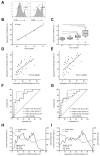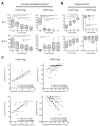A rapid diagnostic test for human regulatory T-cell function to enable regulatory T-cell therapy
- PMID: 22219224
- PMCID: PMC3816350
- DOI: 10.1182/blood-2011-09-380048
A rapid diagnostic test for human regulatory T-cell function to enable regulatory T-cell therapy
Abstract
Regulatory T cells (CD4(+)CD25(hi)CD127(lo)FOXP3(+) T cells [Tregs]) are a population of lymphocytes involved in the maintenance of self-tolerance. Abnormalities in function or number of Tregs are a feature of autoimmune diseases in humans. The ability to expand functional Tregs ex vivo makes them ideal candidates for autologous cell therapy to treat human autoimmune diseases and to induce tolerance to transplants. Current tests of Treg function typically take up to 120 hours, a kinetic disadvantage as clinical trials of Tregs will be critically dependent on the availability of rapid diagnostic tests before infusion into humans. Here we evaluate a 7-hour flow cytometric assay for assessing Treg function, using suppression of the activation markers CD69 and CD154 on responder T cells (CD4(+)CD25(-) [Tresp]), compared with traditional assays involving inhibition of CFSE dilution and cytokine production. In both freshly isolated and ex vivo expanded Tregs, we describe excellent correlation with gold standard suppressor cell assays. We propose that the kinetic advantage of the new assay may place it as the preferred rapid diagnostic test for the evaluation of Treg function in forthcoming clinical trials of cell therapy, enabling the translation of the large body of preclinical data into potentially useful treatments for human diseases.
Figures





Similar articles
-
Rapid assessment of in vitro expanded human regulatory T cell function.J Immunol Methods. 2011 Sep 30;372(1-2):95-106. doi: 10.1016/j.jim.2011.07.001. Epub 2011 Jul 18. J Immunol Methods. 2011. PMID: 21781972
-
Use of CFSE to monitor ex vivo regulatory T-cell suppression of CD4+ and CD8+ T-cell proliferation within unseparated mononuclear cells from malignant and non-malignant human lymph node biopsies.Immunol Invest. 2007;36(5-6):629-48. doi: 10.1080/08820130701674463. Immunol Invest. 2007. PMID: 18161522
-
CD69 enhances immunosuppressive function of regulatory T-cells and attenuates colitis by prompting IL-10 production.Cell Death Dis. 2018 Sep 5;9(9):905. doi: 10.1038/s41419-018-0927-9. Cell Death Dis. 2018. PMID: 30185773 Free PMC article.
-
The pivotal role of CD69 in autoimmunity.J Autoimmun. 2020 Jul;111:102453. doi: 10.1016/j.jaut.2020.102453. Epub 2020 Apr 11. J Autoimmun. 2020. PMID: 32291138 Review.
-
Early Growth Response Gene 2-Expressing CD4+LAG3+ Regulatory T Cells: The Therapeutic Potential for Treating Autoimmune Diseases.Front Immunol. 2018 Feb 26;9:340. doi: 10.3389/fimmu.2018.00340. eCollection 2018. Front Immunol. 2018. PMID: 29535721 Free PMC article. Review.
Cited by
-
Treatment of graft-versus-host disease with naturally occurring T regulatory cells.BioDrugs. 2013 Dec;27(6):605-14. doi: 10.1007/s40259-013-0050-5. BioDrugs. 2013. PMID: 23813436 Free PMC article. Review.
-
Regulatory T Cells in Respiratory Health and Diseases.Pulm Med. 2019 Nov 20;2019:1907807. doi: 10.1155/2019/1907807. eCollection 2019. Pulm Med. 2019. PMID: 31827925 Free PMC article. Review.
-
Isolation of biologically-active exosomes from human plasma.J Immunol Methods. 2014 Sep;411:55-65. doi: 10.1016/j.jim.2014.06.007. Epub 2014 Jun 18. J Immunol Methods. 2014. PMID: 24952243 Free PMC article. Clinical Trial.
-
Monitoring T cell alloreactivity.Transplant Rev (Orlando). 2015 Apr;29(2):53-9. doi: 10.1016/j.trre.2014.11.001. Epub 2014 Nov 12. Transplant Rev (Orlando). 2015. PMID: 25475045 Free PMC article. Review.
-
Induced and natural regulatory T cells in human cancer.Expert Opin Biol Ther. 2012 Oct;12(10):1383-97. doi: 10.1517/14712598.2012.707184. Epub 2012 Jul 31. Expert Opin Biol Ther. 2012. PMID: 22849383 Free PMC article. Review.
References
-
- Atalar K, Afzali B, Lord G, Lombardi G. Relative roles of Th1 and Th17 effector cells in allograft rejection. Curr Opin Organ Transplant. 2009;14(1):23–29. - PubMed
-
- Baecher-Allan C, Hafler DA. Human regulatory T cells and their role in autoimmune disease. Immunol Rev. 2006;212:203–216. - PubMed
-
- Lindley S, Dayan CM, Bishop A, Roep BO, Peakman M, Tree TI. Defective suppressor function in CD4(+)CD25(+) T-cells from patients with type 1 diabetes. Diabetes. 2005;54(1):92–99. - PubMed
Publication types
MeSH terms
Substances
Grants and funding
LinkOut - more resources
Full Text Sources
Other Literature Sources
Research Materials

